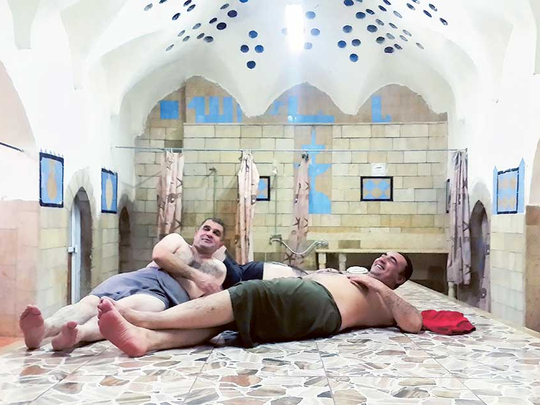
Ramallah: At one time, Palestine had 38 hammams (bathhouses), 10 of which were based in the town of Nablus alone. But today, only two bathhouses remain functional in the city.
The Romans first introduced hammams to the city, and they became extremely popular during the time of the Ottoman Empire from the early 16th to the early 20th Centuries. But Palestine’s more recent history has seen the demise of the once-popular bathhouses, with around 95 per cent becoming deserted.
One of the two functioning bathhouses in Nablus is owned by the Samaritan community, while the other, the Al Shifaa Turkish bathhouse, was renovated and is currently managed by Yousef Fadl Al Jabi.
“The majority of the bathhouses in Nablus have been turned into sweet factories, carpentry workshops and warehouses,” said Al Jabi.
Over the years, people have lost interest in visiting the hammams for various reasons.
“The introduction of solar water-heating systems, and then electric water heaters at homes, meant that spending hours at the hammam started to seem burdensome,” Al Jabi told Gulf News.
“From 1967, when Israel occupied the West Bank, the solar water heater became a common appliance in every household, contributing to the extinction of the bathhouses. The Palestinian market was flooded with cheap Israeli imports of solar water heaters that greatly impacted the popularity of the hammams within Palestinian society.”
But it wasn’t until the first Palestinian uprising (Intifada) in the late 1980s, that the hammams faced near-extinction as communal gathering places were regular targets of Israeli raids.
“Palestinians avoided congregating in the hammams in particular to spare themselves the embarrassment of being arrested naked,” said Al Jabi. “The second Intifada erupted in 2000 and lasted until 2005, a time during which Palestinians lived under an oppressive police-like state,” he said.
After the end of the Second Intifada, Palestinians felt more at ease and slowly began returning to the hammams, which have since witnessed a resurgence in popularity.
“The hammams played a central role in the social life of Nablus in the early days, and now Palestinians are experiencing a rebirth of that culture,” said Al Jabi.
The Nablus-based Tuqan family which originally owned the Al Shifaa bathhouse asked Al Jabi to renovate and manage the bathhouse under the condition that he keep its original activity unchanged in a bid to preserve the city’s culture and heritage.
Hammams are now key tourist attractions in Palestine. Since they have become such a popular trend in the West Bank, the owners of other bathhouses have been encouraged by the Palestinian Ministry of Tourism to renovate their facilities too.
Although Ahmad Hamoudeh has three bathrooms in his luxurious home, he often chooses to bathe in the historic bathhouses (hammams) of Nablus.
In the hammams, Hamoudeh can relax as professionals attend to his bathing needs, while he catches up on the latest gossip of the town with fellow customers.
“Just a few years ago, I viewed the concept of hammams as silly,” Hamoudeh told Gulf News. “One day I decided to go to see what all the fuss was about and I have completely changed my view. There is no match for the level of cleanliness the hammams provide, and they also have major health benefits.”
Manal Saeed, a Nablus-based nutritionist, explained that excessive sweating in the hot and steamy bathhouse has tremendous health benefits as it unclogs pores, increases blood circulation, strengthens the immune system and leaves bathers with healthy, glowing skin.
Hamoudeh, who suffers from degenerative disc disease, says his routine hammam visits have helped ease the pain and discomfort associated with his ailment.
Today, the historic bathhouses have become a popular trend among both men and women.
Gender separation at the hammams is maintained; women are allotted two days of the week to visit.
Lamya Walweel, supervisor on the women-only days, says an additional day needs to be allocated to women to meet the high demand.
“Women visit the historic bathhouses to bathe, have massages, enjoy beauty treatments, chat and in preparation for birthday and wedding celebrations,” she said.
Visiting the Al Shifaa bathhouse is like entering a time warp and stepping back in time.
The Al Shifaa Bathhouse was built in 1225, by traders of the Ayyubid dynasty and retains most of its original features. The floors of the bathhouse were historically heated by burning garbage.
The bathhouse is still characterised by its original massive stone walls and domes which filter sunlight through 700 small round openings filled with multi-coloured glass.
The Al Shifaa Bathhouse has also become a popular place for grooms to ceremonially bathe ahead of their wedding night.
Grooms used to shave and bathe at the house of relatives or friends, but more and more men are now going to the hammams as it has become a growing fad.
So much so that wedding processions (zaffa in Arabic) often start directly at the bathhouse, where singing and dancing friends and family members escort the groom to the wedding hall.












